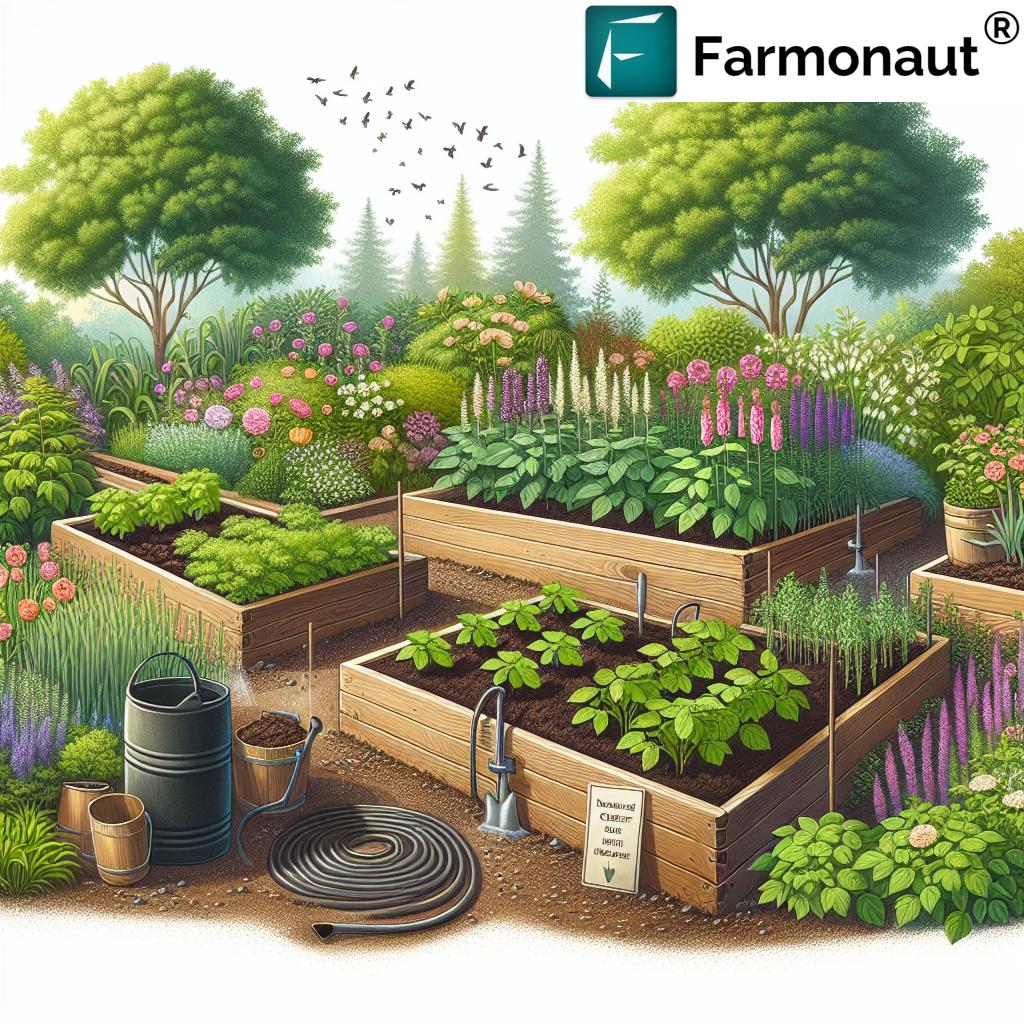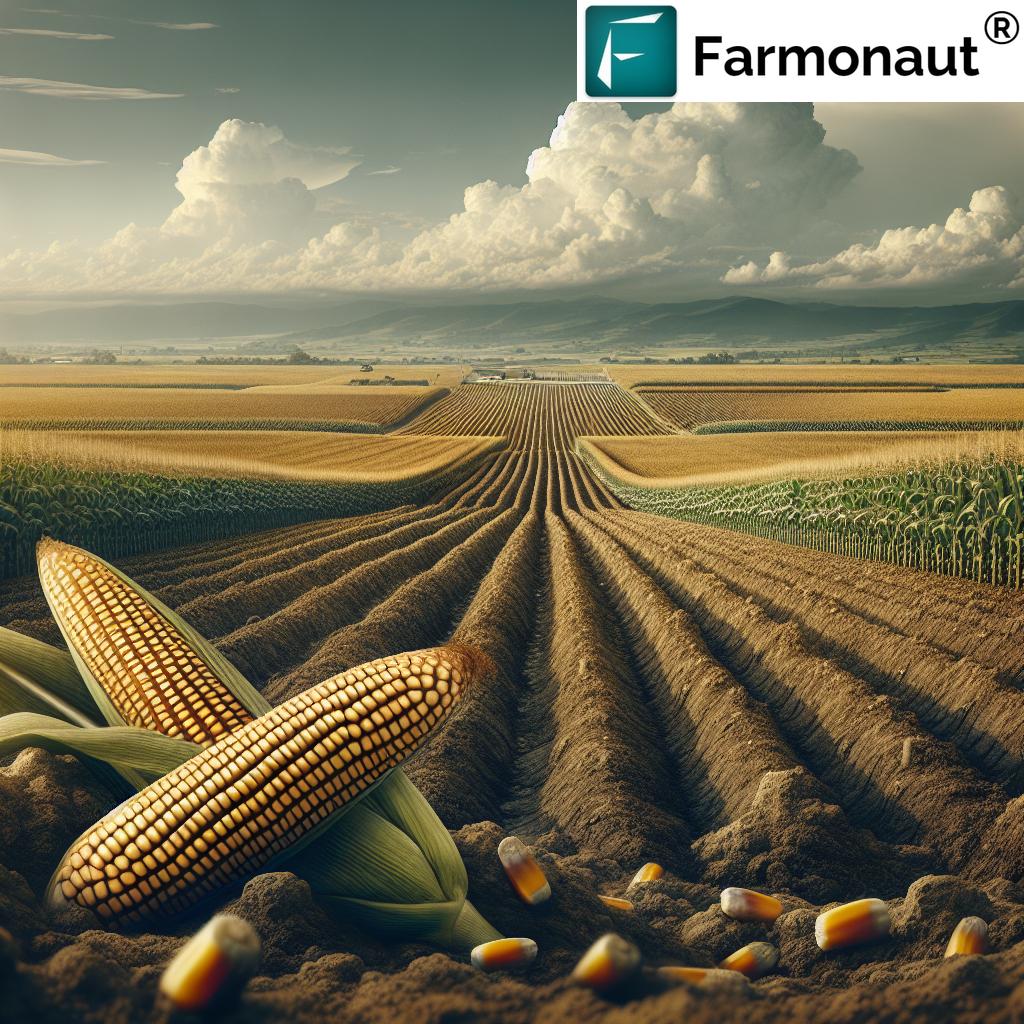Farmer Crop Rotation Techniques for Sustainable Agriculture in 2025: Boost Soil Health, Yields, and Resilience
“Crop rotation can increase soil organic matter by up to 20% in just five years.”

Explore Farmonaut’s Smart Farming Tools
- Summary: Crop Rotation—A Cornerstone for 2025
- Why Crop Rotation Technique Matters in Agriculture
- How Crop Rotation Works: Principles and Patterns
- Key Crop Rotation Techniques and Types
- Comparison Table of Crop Rotation Techniques and Their Estimated Impact
- Sustainable Benefits: Soil Health, Pest Management, and Economic Viability
- Crop Rotation Agriculture in 2025: Modern Innovations & Challenges
- Farmonaut: Advancing Crop Rotation with Precision Farm Management
- FAQ—Farmer Crop Rotation Techniques in Sustainable Agriculture
- Farmonaut Subscriptions
Summary: Crop Rotation—A Cornerstone for 2025
In the evolving landscape of agriculture and farming systems, sustainable agricultural techniques are increasingly vital to ensure food security, environmental health, and economic viability. Among agricultural farming techniques, crop rotation stands apart as one of the oldest and most effective methods. In 2025 and beyond, understanding and implementing crop rotation techniques is more crucial than ever for farmers, foresters, and professionals aiming to maximize productivity while preserving natural resources.
Crop rotation—the systematic practice of growing different crops sequentially on the same land—breaks pest and disease cycles, improves soil fertility, and enhances crop yields. This cornerstone technique helps create a resilient ecosystem within farming and forestry systems, supporting sustainable food systems for the future.
Why Crop Rotation Technique Matters in Agriculture
Crop rotation agriculture is rooted in centuries of observation and scientific progress. Unlike monoculture, which focuses on repeatedly planting a single crop on the same land, rotation alternates different crop types over several seasons or years. This strengthens the soil structure, promotes nutrient cycling, and builds a natural defense against pests, weed, and diseases.
- Sustainable agriculture technique: Rotation helps maintain soil health, biodiversity, and ecosystem services.
- Reducing chemical use: By breaking pest cycles and improving fertility, rotation reduces the need for synthetic fertilizers and pesticides.
- Improving resilience: Diverse cropping systems are better able to adapt to climate variability and mitigate environmental challenges in 2025 and beyond.
The practice of crop rotation is embraced globally, with approaches tailored to specific climates, goals, and soil types.
How Crop Rotation Works: Principles and Patterns
Crop rotation is a systematic approach to land management that maximizes soil health and productivity by alternating crops with different nutrient requirements, root structures, and growth habits. Here’s how the process works:
1. Sequential Planting
- Growing crops in sequence: Instead of growing a single crop repeatedly (monoculture), farmers plant different crops in a set order (rotation cycles). For example, a cereal (wheat) one year is followed by a legume (peas) the next.
- Duration: A rotation can span two, three, or more years depending on goals, climate, and market needs.
2. Different Crop Types and Functions
- Cereals (wheat, maize, barley): Generally high nitrogen consumers and widely used in global rotations.
- Legumes (beans, peas, lentils): Fix atmospheric nitrogen naturally via symbiotic bacteria in their root nodules, enriching the soil for subsequent crops.
- Root and tuber crops (potatoes, carrots): Break up soil compaction and improve water infiltration.
- Cover crops (clover, vetch): Sown in between main crops to add organic matter, suppress weeds, and protect soil from erosion.
3. Breaking Pest and Disease Cycles
- Crop rotation disrupts the life cycles of crop-specific pests and pathogens that may persist in the soil if the same crop is repeatedly planted.
- Changing host availability forces pests and diseases out, reducing chemical intervention needs.
4. Enhancing Soil Fertility & Nutrient Cycling
- Different crops use nutrients from various soil levels, minimizing depletion and restoring balance.
- Legumes fix nitrogen naturally, replenishing levels and reducing dependence on synthetic inputs.
- Deep-rooted plants improve root zone structure, aid in subterranean aeration, and enhance water management.
5. Promoting Biodiversity Within the Farm Ecosystem
- Rotating a wide range of species creates diverse habitats—for microbes, pollinators, and beneficial insects—enhancing resilient systems.
Learn how satellite-based crop health monitoring from Farmonaut can optimize every rotation season for maximum yields and sustainability.
Key Crop Rotation Techniques and Types
Farmer: agricultural techniques such as crop rotation are adaptable and customizable. Here are several tried-and-tested crop rotation techniques in practice:
Two-Year Rotation (Basic)
- Year 1: Cereal crop (wheat, maize, or barley)
- Year 2: Legume (beans, peas, lentils)
- Benefit: Rapid nitrogen recharge and good pest/disease break.
Three-Year Rotation (Diversified)
- Year 1: Cereal/grain
- Year 2: Legume or nitrogen-fixing cover
- Year 3: Root/tuber or broad-leaf crop (potato, sugar beet, sunflower)
- Benefit: Improves soil structure, suppresses varied weeds, disrupts more pest cycles.
Four-Year (or Longer) Advanced Rotations
- Examples: Cereal → Legume → Root crop → Oilseed → Cover crop
- Benefit: Strong resilience against most pests/weeds/diseases, optimizes nutrient usage, enhances biodiversity
Legume Integration (Nitrogen Cycle Enhancer)
- Purpose: Insert legumes numerous times throughout the rotation, maximizing nitrogen fixation.
Cover Crop Inclusion
- Use: Sow clover, vetch, or rye between cash crops.
- Benefit: Shield soil from erosion, boost organic matter, and act as a weed suppressant.
Specialized Crop Rotation for Agroforestry Systems
- Agroforestry: Integrate crop rotation with rows of nitrogen-fixing trees or shrubs.
- Benefit: Natural soil enrichment, carbon sequestration, and improved long-term sustainability.
The quality of your soil underpins every successful crop rotation. Learn more about nurturing soil for sustainable farming.
Interested in satellite data for your farm? Explore our API for seamless integration of soil, crop, and weather analytics.
|
Developer Docs
Download the Farmonaut app to leverage satellite-based precision agriculture for every crop rotation season!
Comparison Table of Crop Rotation Techniques and Their Estimated Impact
| Crop Rotation Technique | Description | Estimated Improvement in Soil Health (%) | Estimated Increase in Crop Yield (%) | Key Sustainability Benefit | Relevant Innovations (2025) |
|---|---|---|---|---|---|
| Two-Year Rotation | Alternation between cereal and legume (e.g., wheat–pea) | +15% | +10% | Nitrogen replenishment, pest break | Remote crop health monitoring, AI planning |
| Three-Year Rotation | Cereal, followed by legume, then root crop | +18% | +12% | Increased pest/disease resistance | Automated rotation scheduling, soil moisture analytics |
| Legume Integration | Frequent legumes in rotation (cover/intercrop) | +20% | +15% | Maximized nitrogen fixation, reduced fertilizers | Bespoke legume varieties, digital nitrogen mapping |
| Cover Crop Inclusion | Adding non-cash crops for soil cover and health | +17% | +11% | Soil structure, weed suppression, erosion control | Multispectral satellite imaging, AI weed detection |
| Agroforestry Rotation | Crop rotation between rows of trees/shrubs | +22% | +13% | Biodiversity, carbon sequestration | Carbon footprint tracking, blockchain traceability |
Soil organic carbon is a cornerstone of soil health and crop rotation success—see why it matters for every farmer using sustainable agriculture techniques.
Sustainable Benefits: Soil Health, Pest Management, Economic Viability
“In 2025, farms using crop rotation report up to 15% higher yields compared to monoculture systems.”
Crop rotation sustainable agriculture techniques unlock a variety of tangible benefits that compound with time. These advantages span environmental, economic, and social domains, making rotation a key part of future-proofing agriculture:
Soil Fertility and Health
- Diversified biological activity: Various crops foster a richer ecosystem of microbes and fauna, which aids organic matter breakdown and soil aeration.
- Nutrient balance: Legume crops (like beans, peas, and lentils) fix atmospheric nitrogen, replenishing nitrogen levels and reducing need for synthetic fertilizers. Deep-rooted plants help mine nutrients from lower soil layers.
- Soil structure improvement: Alternating root systems (deep and shallow) breaks up compaction, improves infiltration, and enhances both surface and subterranean soil structure.
Healthy, carbon-rich soil is the backbone of crop rotation’s long-term success.
Pest, Disease, and Weed Management
- Disrupting monoculture cycles: Alternating different crops breaks pest and disease cycles, lowering infestations and infections naturally.
- Weed suppression: Different planting dates, canopy cover, and growth habits crowd out weeds and reduce reliance on herbicides.
- Resilient systems: Continuous change in crop types and seasons makes farms less hospitable for persistent pests and pathogens.
Water Conservation and Resource Management
- Diverse root structures: Better water retention, reduced runoff, and increased drought resilience as climate variability continues in 2025.
- Reduced erosion: Cover and deep-rooted crops strengthen both surface and subsoil, anchoring soil in place.
Farmonaut’s carbon footprinting tools help quantify the sustainability lift from improved water and nutrient management. Visit our Carbon Footprinting Solutions for actionable metrics and compliance support.
Economic Resilience
- Diversification: Spreading risk among different crop types and markets boosts stability and reduces exposure to price crashes or crop failures.
- Lower input costs: Natural pest control and nitrogen-fixing reduce annual expenditure on agrochemicals.
Secure your harvests and improve long-term profits with our crop loan and insurance verification solutions, leveraging satellite-based monitoring for fast approvals and transparency.
Environmental Stewardship
- Biodiversity: Crop rotation increases farm wildlife diversity, supporting pollinators and beneficial arthropods.
- Carbon sequestration: More organic matter and less disturbance allow farming to capture more atmospheric carbon.
Precision tools and AI-driven analytics are enhancing the benefits of rotation by making every decision data-driven in 2025.
Crop Rotation Agriculture in 2025: Modern Innovations & Challenges
While crop rotation has a long history, modern agriculture in 2025 is innovating traditional practices through technology and research. Here’s how:
Challenges in the Modern Landscape
- Large-scale monoculture pressure: Industrialized farms are incentivized toward single-crop systems due to machinery, contracts, and logistics.
- Market demand: Uniform supply chains sometimes resist multi-crop outputs.
- Knowledge and resource barriers: Planning multi-year, multi-crop strategies can be complex without access to precise data.
Key Innovations in Crop Rotation for 2025
- Satellite-based monitoring: Systems like Farmonaut use satellite imagery to deliver real-time insights on crop health, soil moisture, and rotation performance, making large and small-scale rotations manageable and efficient.
- AI and digital advisory: Farmonaut’s Jeevn AI advisory system offers seasonal recommendations personalized for each field, factoring in weather, crop history, and soil conditions to maximize rotation benefits.
- Blockchain traceability: Crop rotation products, when tracked via blockchain technology, offer end-to-end transparency for consumers and supply chain assurance for brands, especially for diversified rotations.
- New crop breeding: In 2025, focused breeding for crops suited specifically to rotations (e.g., drought-resistant legumes or high-yielding cover crops).
- Fleet and resource management: Farmonaut’s fleet management apps optimize routes for mixed-rotation planting and harvesting.
- Smart large-scale management: For cooperatives, agribusinesses, and agroforestry managers, see large-scale farm management solutions—these platforms aggregate satellite, crop, and logistics data for informed rotation planning on hundreds or thousands of hectares.
Innovative coffee agroforestry models, shown here in Africa, depend on smart crop rotation for soil health, profits, and climate adaptation.
Farmonaut: Advancing Crop Rotation with Precision Farm Management
At Farmonaut, our mission is to make precision agriculture accessible and affordable for every farmer, empowering more sustainable, resilient crop rotation agriculture no matter the land size or location.
- Real-time crop monitoring: Using satellite-based vegetation health, soil moisture, and crop status indices, farmers can spot nutrient stress, disease, or moisture anomalies and adjust rotation patterns on the fly.
- AI-based recommendations: Our Jeevn AI provides personalized advice for which crops to plant, when to rotate, and how to optimize yields, integrating climate forecasts and previous rotation history.
- Carbon footprint tracking: We help quantify sustainability progress, making each rotation a step toward climate goals. (Explore carbon solutions)
- Blockchain traceability: Certify the journey of your products from seed to shelf, ensuring consumer trust in regenerative crop rotation practices. (More on traceability)
- Sensor & app-based tools: Mobile, web, and API solutions fit every farm—plan, monitor, and manage all your agricultural rotations in one smart dashboard.
Circular, resource-efficient agriculture pairs with robust crop rotation for a truly sustainable food system.
Best Practices for Implementing Crop Rotation Agriculture in 2025
Start with these science-backed tips for the smoothest transition to sustainable crop rotation:
- Evaluate your land: Assess current soil health, nutrient levels, and field history with tools like satellite imagery and soil testing.
- Choose the right rotation for your climate and market: Consider local weather patterns, crop suitability, and buyer demand.
- Integrate legumes and cover crops regularly: These naturally fix nitrogen, build organic matter, and renew tired soils.
- Alternate deep- and shallow-rooted crops: Prevents compaction and keeps both surface and subterranean soil zones healthy.
- Record and analyze every cycle: Use farm management apps to keep detailed records, spot patterns, and adjust for best results.
- Leverage digital and satellite tools: Platforms like Farmonaut provide comprehensive, accessible data-driven support for every crop and rotation plan.
Frequently Asked Questions: Farmer Crop Rotation Techniques for Sustainable Agriculture
Q1: What is crop rotation and why is it a cornerstone of sustainable agriculture?
Crop rotation is the systematic planting of different crops sequentially on the same land to improve soil health, disrupt pest and disease cycles, and maintain long-term productivity. It supports a resilient ecosystem, reduces dependency on chemical inputs, and helps build food security.
Q2: What are the typical crop types used in rotations?
Common types used include cereals (wheat, maize), legumes (beans, peas, lentils), root and tuber crops (potato, carrot), and cover crops (clover, rye, vetch). Each serves a different role in nutrient cycling and pest management.
Q3: How does rotation compare with monoculture farming?
Unlike monoculture, crop rotation reduces pest and disease issues, improves soil fertility, and often yields better economic and environmental results—especially in 2025 where climate and resource pressures are high.
Q4: What are the main challenges in adopting rotation?
Challenges include the complexity of planning rotations, access to crop and soil data, market preferences for monocultures, and operational constraints for large-scale farms. However, digital tools and satellite-based management (like those by Farmonaut) help overcome these challenges.
Q5: Can I track soil health and plan crop rotations automatically?
Yes! Solutions like Farmonaut’s smart analytics dashboard allow you to track soil health, vegetation indices, moisture, and more. This enables precision planning and ongoing optimization of your crop rotation practices.
Q6: Is crop rotation beneficial for small farmers as well as large operations?
Absolutely. While techniques might vary (e.g., shorter rotations for market gardens; multi-year advanced cycles for commercial farms), the benefits apply to all scales: improved yields, lower costs, enhanced soil structure, and greater resilience.
Farmonaut Subscriptions—Make Precision Crop Rotation Affordable in 2025
Ready to optimize your crop rotation agriculture? Get affordable, data-driven management for sustainable and profitable farming. Flexible plans for individual farmers, agribusinesses, and government stakeholders.
Conclusion: Crop Rotation—A Resilient Path for Sustainable Farming in 2025
Crop rotation continues to be a vital, resilient, and fundamental practice for sustainable agriculture in the modern era. It is the bridge connecting traditional wisdom to data-driven innovations, and its integration with satellite analytics, AI, and blockchain makes it more powerful and achievable in 2025 than ever before. With best-in-class technologies and a resolve to enhance both yield and environmental outcomes, crop rotation is truly the cornerstone of a brighter, more sustainable food future.
Whether you manage a smallholder plot, a large agro-enterprise, or a forestry project, embracing advanced farmer crop rotation techniques is your step toward sustainability, productivity, and long-term profitability.








